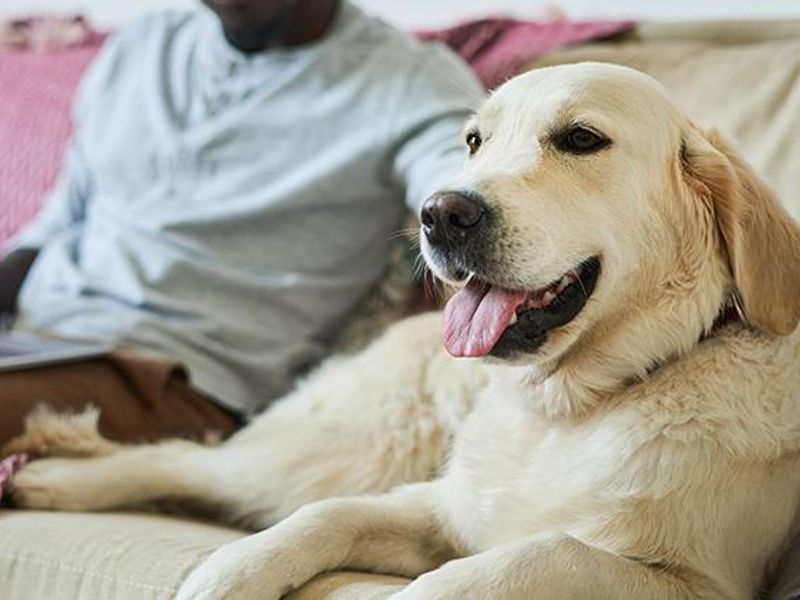How to make your dog happy
Our top ten tips will help ensure you make your dog as happy as they make you.

Top 10 tips for keeping your dog happy
Dogs bring so much happiness to our lives. That’s why it’s so important that we do everything we can to ensure that their needs are met so they are happy and healthy, too.
Find out how to make your dog happy with our top 10 tips, as well as advice to help you know exactly how your pooch is feeling.
Tip one: Make sure they’re comfortable
You want to ensure that your dog has somewhere to relax and sleep in comfort. A clean, dry, cosy, padded bed, or even a snug blanket in their favourite spot, will be perfect. Ideally give them somewhere quiet they can retreat to undisturbed if they’d like their own space.
This should be away from loud noises or bustling family rooms. Some dogs prefer the nest-like feeling of a crate or doggy den as it makes them feel safe. So, consider trying one if your dog seems uncomfortable in the open.
Tip two: Pay attention to their diet and nutrition
The ingredients in your dog’s food can make a difference to their health and wellbeing. Check to make sure you’re buying food that is suitable for their size, age and level of activity.
Different dogs have different dietary requirements. Speak to your vet for advice on which dog food is most suitable for yours.
Tip three: Provide appropriate exercise
Dogs need regular exercise for both their physical and mental wellbeing. Getting outside and going on walks gives them a chance to stretch their legs, have a good sniff and get some fresh air.
Before letting your dog off-lead, just make sure you have trained them to come back when called.
Likewise, ensure they are wearing a collar with an ID tag and that their microchip details are up to date, in case they get lost.
Remember, if they are going to be left alone at home, you should always give your dog a walk first and allow them to go to the toilet before you head out.
Tip four: Keep their mind active as well as their body
Dogs are active and intelligent animals. So, it’s important to provide them with safe and suitable opportunities to exercise their mind, as well as their body.
Great ways to enrich your dog’s life include:
- interactive puzzle-feeders
- playing with a range of toys
- scattering treats for them to sniff out
- reward-based training sessions.
These are perfect for preventing boredom (which might lead to destructive behaviour) and teaching your pup new skills. These activities are also a good way to tire out dogs that need restricted exercise, such as those recovering from surgery.
For more ideas, take a look at our enrichment activities.
Tip five: Ensure they maintain a healthy weight
It’s tempting to give into those puppy dog eyes and feed your dog the food you are eating.
Firstly, not all human food is good for dogs – in fact, some of it is toxic and you could end up doing more harm than good.
Likewise, too many treats (and not enough exercise) could cause them to put on too much weight.
That’s not to say you can’t treat them – you definitely should, particularly when training. Just make sure you change the size of their main meal to accommodate this and that you consider what you are giving them.
That, alongside regular exercise, will help to keep them in good shape and healthy.
Tip six: Provide fresh, clean water daily
Your dog must always have access to fresh, clean water. This is always important but particularly on a hot summer’s day.
As well as providing them with a drink at home, you should also be able to offer them water if you are out for the day or on a long walk.
Tip seven: Consider their individual personality
All dogs are unique with their own personalities and needs.
While some pups love to snooze and snuggle, others love playing fetch. Some might enjoy long walks with doggy pals, while others prefer pottering and sniffing around the garden on their own.
It’s important to get to know your dog. Then you can structure their routine and the activities they do during the day around this.
Tip eight: Train them to build their confidence
Training your dog using reward-based methods is very important and should start as soon as possible. It will help to keep them safe as well as ensure they grow into confident dogs.
It can also help to prevent behaviour problems from developing. For example, to avoid separation anxiety developing you need to teach them to be comfortable spending time alone.
It may be hard to leave that bundle of fluff. But, if you teach them while they are young, you’ll avoid the stress it can cause them as they get older. Other useful life skills include teaching your dog to settle and to walk nicely on lead.
Tip nine: Regular visits to the vet and groomer
From clipping nails and cleaning fur to health check-ups and vaccinations – vets and groomers will help keep your dog looking and feeling healthy. While all dogs must visit the vet regularly, only certain breeds will need regular trips to the groomers.
Before you go to either, it’s important to get them used to being handled at home. That way they will be comfortable with this before someone else does it.
Then, in between, keep on top of what you need to at home such as flea treatment and worming tablets. If you notice any changes in your dog’s behaviour or have any concerns about their health, contact your vet for a check-up. Find out more about happy vet visits.
Tip 10: Show them love and affection
Doing all the above will help your dog feel safe and cared for. Remember, be gentle and kind.
Avoid telling your dog off as this may worry or confuse them. Instead, praise and reward good behaviour. This will help them to learn how you would like them to behave and will help to build a bond between the two of you.
How can you tell if your dog is happy?
Dogs can’t speak to us to let us how they feel. They can, however, tell us through their body language and behaviour.
You know your dog best, of course. But you can get to know them even better if you spend time understanding their body language and how they communicate.




